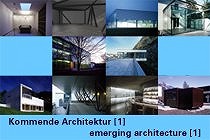
|
Emerging Architecture 1 - Kommende Architektur 1 10 offices Location: Architekturzentrum Wien - Old hall Exhibition: 21 September 2000 - 30 October 2000 Opening Hours: daily 10:00 A.M to 7:00 P.M. Opening: Wednesday 20 September 2000, 7pm Marte.Marte Totengasse 18 A-6833 Weiler A U S T R I A Phone +43 (5523) 52 587 Fax +43 (5523) 52 587-4 marte.marte@marte-marte.com www.marte-marte.com Bernhard Marte Born in 1966 in Weiler/Vorarlberg. 1985 - 1993 studied Architecture at the TU Innsbruck. Since 1993, joint office with Stefan Marte. Stefan Marte Born in 1967 in Weiler/Vorarlberg. 1987 - 1995 studied Architecture at the TU Innsbruck. Buildings, Projects (selection): 1992 - 1994 Weiler’s chapel of rest 1996 - 1997 Redesign of Weiler’s cemetery 1996 - 1997 Residential building- Dr. Frick, Röthis’ house 1997 Holiday apartment belonging to Dr. Matt, Lech 1997 - 1998 Weiler’s primary school and grammar school 1992 - 1999 Residential building in Dafins 1998 - 1999 The Frödisch bridge, Sulz/Vorarlberg On the Vorarlberg scene, which is full of good buildings, Marte.Marte take a controversial stance. The modern tradition of the architect is influenced very strongly there by the linear structure of a wooden construction and the typology of a single house. In traditional, as well as contemporary architecture, conditioned by the local climate there, a structure is built as compactly as possible and seeks only to find a balanced position within the terrain, but otherwise establishes a rather abrupt contrast between inside and outside. The architecture of Marte.Marte contradicts both of these fundamental principles, does this, however, with the same sobriety and consistency, as a superior component of Alemannic creativity would do. Marte.Marte work with monolithic, poured concrete planes as opposed to a carpenter‘s light, scaffolding-like structure. Unlike the solitary boxes of old and new houses in the region, they try to grasp the surroundings of buildings architecturally, to make them livable by creating a measured, shielded and staggered transition from the individual to the general. They do not merely replace the wooden box with a concrete box, it is much more the break-up of the classical block-like cube into shells full of angles and three-dimensional fragments of boxes. At the House in Röthis, for instance, living space was primarily developed by the use of walls of different heights, which shield the site from the rest of the large plot. The concrete walls begin by forming courts and lanes, and then consolidate to become the building itself on ground level, on top of which the bedrooms are situated in the form of an introverted wooden prism. [...] |
 |
|
|
|
Current Preview Permanent Exhibition Emerging Architecture 1 - Kommende Architektur 1 Press Release The 10 offices * Bulant & Wailzer * Peter Ebner * Geiswinkler & Geiswinkler * Kaufmann 96 GmbH * Rainer Köberl * lichtblau . wagner * Marte.Marte * Pichler & Traupmann * Riepl Riepl * Splitterwerk Gallery: Emerging Architecture 1 - Kommende Architektur 1 E-Shop Products: Book: Emerging Architecture 1 / Kommende Architektur 1 DVD: Emerging Architecture 1 - Kommende Architektur 1 Information: Ines Purtauf Tel.: +43 (1) 522 31 15 - 25 Fax: +43 (1) 522 31 17 Email: purtauf@azw.at |
| © Architekturzentrum Wien 2025 |
||



